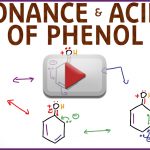Carbocations arise so frequently in Organic Chemistry that recognizing them must become second nature. After reading this tutorial, you should be able to eyeball a molecule and determine where a carbocation is likely to form as well as its potential stability. This will help you master carbocation intermediate reactions down the line including Markovnikov alkene addition […]
Phenol Resonance and Acidity Organic Chemistry Video
Phenol is a unique alcohol due to having a benzene ring and associated resonance. This video walks you through phenol resonance structures to help you understand how resonance impacts its acidity. Examples include comparing phenol to acetic acid as well as the impact of substituents on the ring like nitrophenol. (Watch on YouTube: Phenol Resonance/Acidity. Click […]
Resonance Trick Ortho Meta Para Addition EAS Intermediates
EAS Series: Video 10 Electrophilic Aromatic Substitution gets more difficult when the starting molecule is a substituted benzene. Not only do you have to know the reaction. You also have to know how the substituent will direct the incoming electrophile, and if the substituent will slow down (deactivate) or speed up (activate) the overall reaction. […]
EAS Mechanism and Sigma Complex Resonance Video
EAS Series: Video 2 The Electrophilic Aromatic Substitution reaction starts when one of the pi electrons on the benzene rings breaks as it reaches for the super electrophile. While this is similar to alkene reactions AT FIRST GLANCE the remainder of this mechanism is very different and unique. The sigma complex intermediate is capable of […]
Resonance Structures of Benzene
Benzene is a unique molecule when it comes to resonance structures. This video will show you how to draw the ‘circle’ of resonance for benzene, as well as resonance intermediates for substituted aromatic compounds including Electron Donating Groups EDG which resonate into the ring and Electron Withdrawing Groups EWG which cause resonance out of the ring. […]
Resonance Effect on Acidity in Organic Chemistry
Video 5 in the acid/base tutorial video series shows you how to use conjugate base resonance to determine the strength or stability of conjugate bases. If you can logically understand how resonance effects stability you’ll have an easier time determining acidity of neutral starting acid molecules. (click HERE to watch this video on YouTube. Catch […]








